Bicycle gangs of Los Angeles: The quintessential car city is in the throes of a cycling revolution
Along with a new bike path that will run alongside the LA river, the city is hosting an ever-increasing collection of organised group rides through its near-deserted late-night streets. Tim Walker joins one of the most celebrated, successful and serious of these regular rides, the Wolfpack Hustle, for its annual Midnight Drag Race
Your support helps us to tell the story
From reproductive rights to climate change to Big Tech, The Independent is on the ground when the story is developing. Whether it's investigating the financials of Elon Musk's pro-Trump PAC or producing our latest documentary, 'The A Word', which shines a light on the American women fighting for reproductive rights, we know how important it is to parse out the facts from the messaging.
At such a critical moment in US history, we need reporters on the ground. Your donation allows us to keep sending journalists to speak to both sides of the story.
The Independent is trusted by Americans across the entire political spectrum. And unlike many other quality news outlets, we choose not to lock Americans out of our reporting and analysis with paywalls. We believe quality journalism should be available to everyone, paid for by those who can afford it.
Your support makes all the difference.From the Sixth Street Bridge, there's a fine view of the fierce pink sunset over downtown Los Angeles, but Edgar Juarez is interested only in the tarmac. It's a warm evening in early September, and Juarez, a 29-year-old electrician from Long Beach, California, is preparing to take part in the second annual Wolfpack Hustle Midnight Drag Race.
In the coming hours, 200 riders will race their fixed-gear bicycles, one-on-one, across the famous viaduct. The 16 with the fastest times will return to the track sometime after midnight, to sprint off for a spot on the podium. Juarez – lean and compact in his spandex cycling bib, and missing some front teeth following a recent crash – expects to be among them.
The Drag Race is the last of three events in the 2013 Wolfpack Hustle Unified Title Race Series, which began with the perilous, semi-legal Marathon Crash Race. Held in March, early on the morning of the LA Marathon, the race sees some 4,000 riders of wildly varying proficiency pedal the 26.2-mile marathon course before the runners arrive.
Juarez, whose cycling nickname is 'Willo', won the 2012 Crash Race, and wears the coveted gold medal substitute – a set of military-style dog tags – dangling from his neck to prove it. He's been racing competitively for around 18 months. Before that, he cycled merely for fun. But after he tore his meniscus playing football, he started riding more seriously to help the healing process. "I'm an athlete," he says. "I love the competitive side of any sport. I found out there were cycling competitions, and I've been participating ever since."
Going into tonight's Drag Race, Juarez lies fifth in the table for the 2013 Series. His two young daughters have been allowed out late to watch him contest the title. "I think my chances are good," he says, shaking out his powerful limbs. "I feel really good tonight."
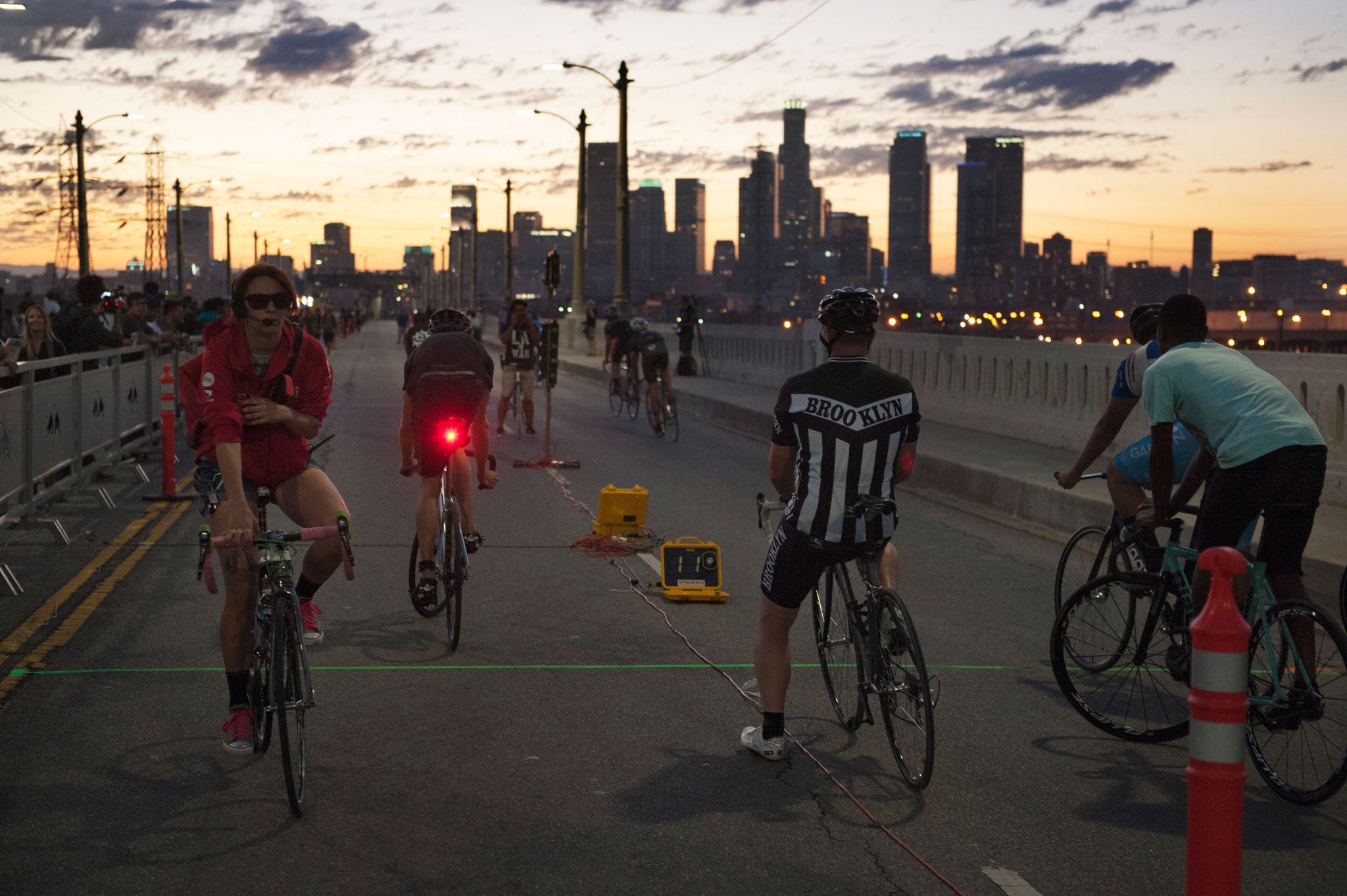
Los Angeles, the world's quintessential car city, is in the throes of a cycling revolution. On a recent Sunday, seven-and-a-half miles of regularly congested downtown streets were closed to cars for the city's eighth 'CicLAvia' event in four years: cyclists and skaters were given the run of the roads, and more than 100,000 people turned up.
In 2010, LA's then-mayor Antonio Villaraigosa shattered his elbow after his bicycle collided with a cab. Several months later, the city introduced a bike plan calling for its 338 miles of bike lanes to be increased to 1,684. A bike path running for 51 miles alongside the LA river – which flows from the Valley to the Ocean, beneath the Sixth Street Bridge – is due for completion by 2020.
At the heart of the LA cycling phenomenon is an ever-increasing collection of organised group rides through the city's near-deserted late-night streets. One of the most celebrated, successful and serious of these regular rides is led by Wolfpack Hustle, the outfit behind tonight's Midnight Drag Race.
Along the length of the Bridge, which is officially car-free for the night, riders and their teams idle beside the track beneath temporary gazebos, as if in the pits for a hipster Grand Prix. They stretch, they chat, they cycle on the spot. Some, like Willo, wear professional cycling gear; others have turned up on BMXs in shorts and T-shirts.
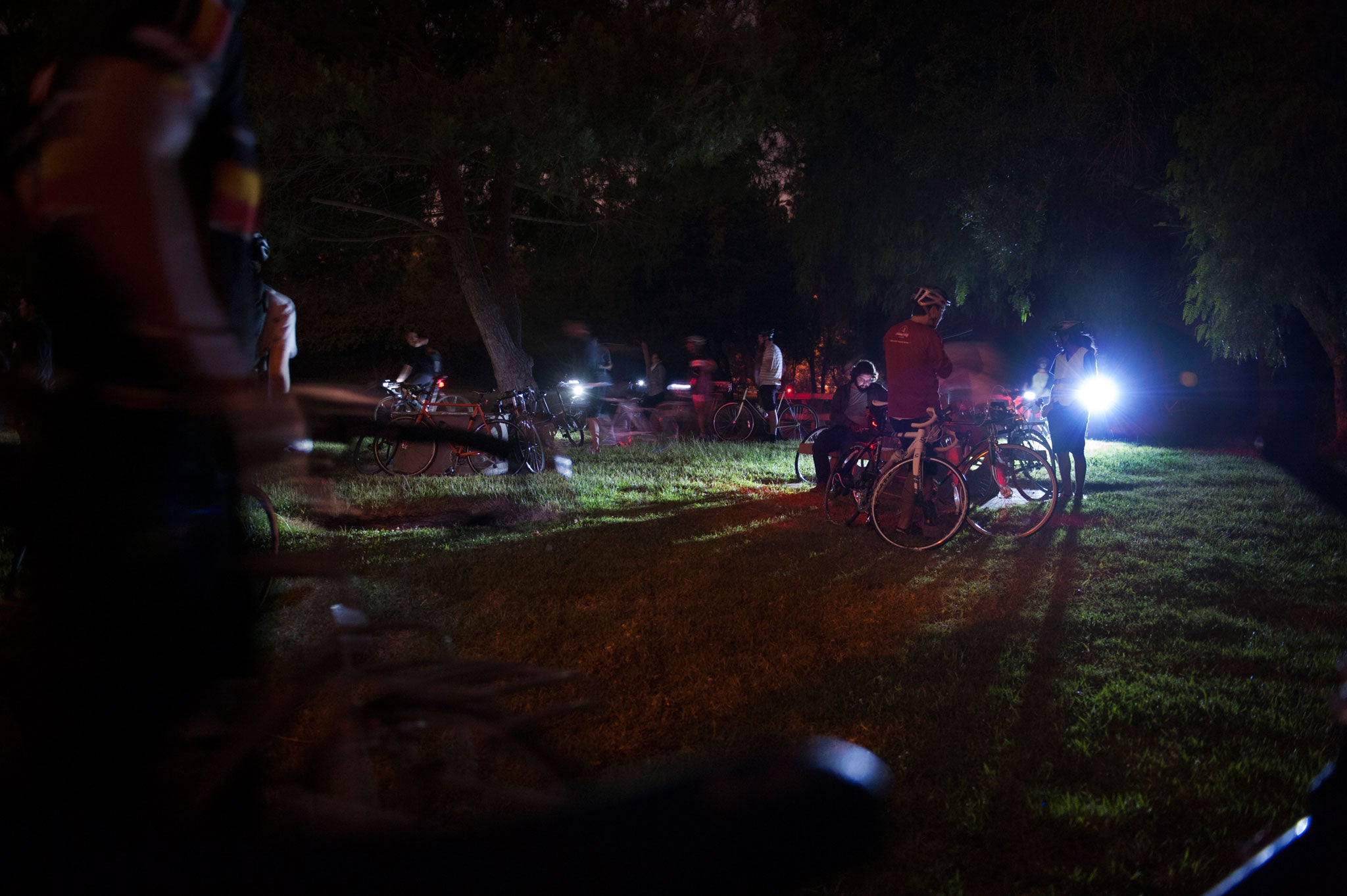
The teams are based loosely around the bike shops of Southern California. Arthur Alfaro, a 16-year-old high school student from the northern suburb of Mission Hills, is the youngest in a handful of riders backed by his local shop, Fix Fixie. As he watches the organisers paste quick-drying concrete over the cracks in the road, he talks me through the particulars of his impressive bicycle: a steel-framed Leader 722 Heritage Edition, with American Classic 420 Aero 3 wheels, Japanese NJS-stamped Sugino 75 Cranks and a Thompson seatpost.
Alfaro earnt credit to pay for the costly parts by working as an apprentice at the shop. "I learnt all about bikes there," he explains. "How to build them, how to fix them. If I'm not at home, I'm at the bike shop. It's like a second home." Of the city's cycling scene, he says, grinning: "Everyone's nice to each other, everyone's friends. It's a real thrill. It's a community".
The de facto spokesperson for the LA bike community is Don Ward, known to most as 'Roadblock' for his six-foot-eight frame and his habit of using it to hold up traffic at intersections while fellow riders make a turn. Ward, aged 40, grew up in Hollywood and spent his early adult years skateboarding, making street art and playing in a punk band. His subsequent career in web and graphic design has been curtailed in the past year by his responsibilities as the lead organiser for the Wolfpack Hustle Series.
Ward's association with the cycling scene began in February 2004, when his friend Kim Jensen came up with the idea of a guided, night-time bicycle tour of historic Los Angeles fountains. She called that first ride the Downtown Fountain Tour, and named the embryonic group 'Midnight Ridazz'.
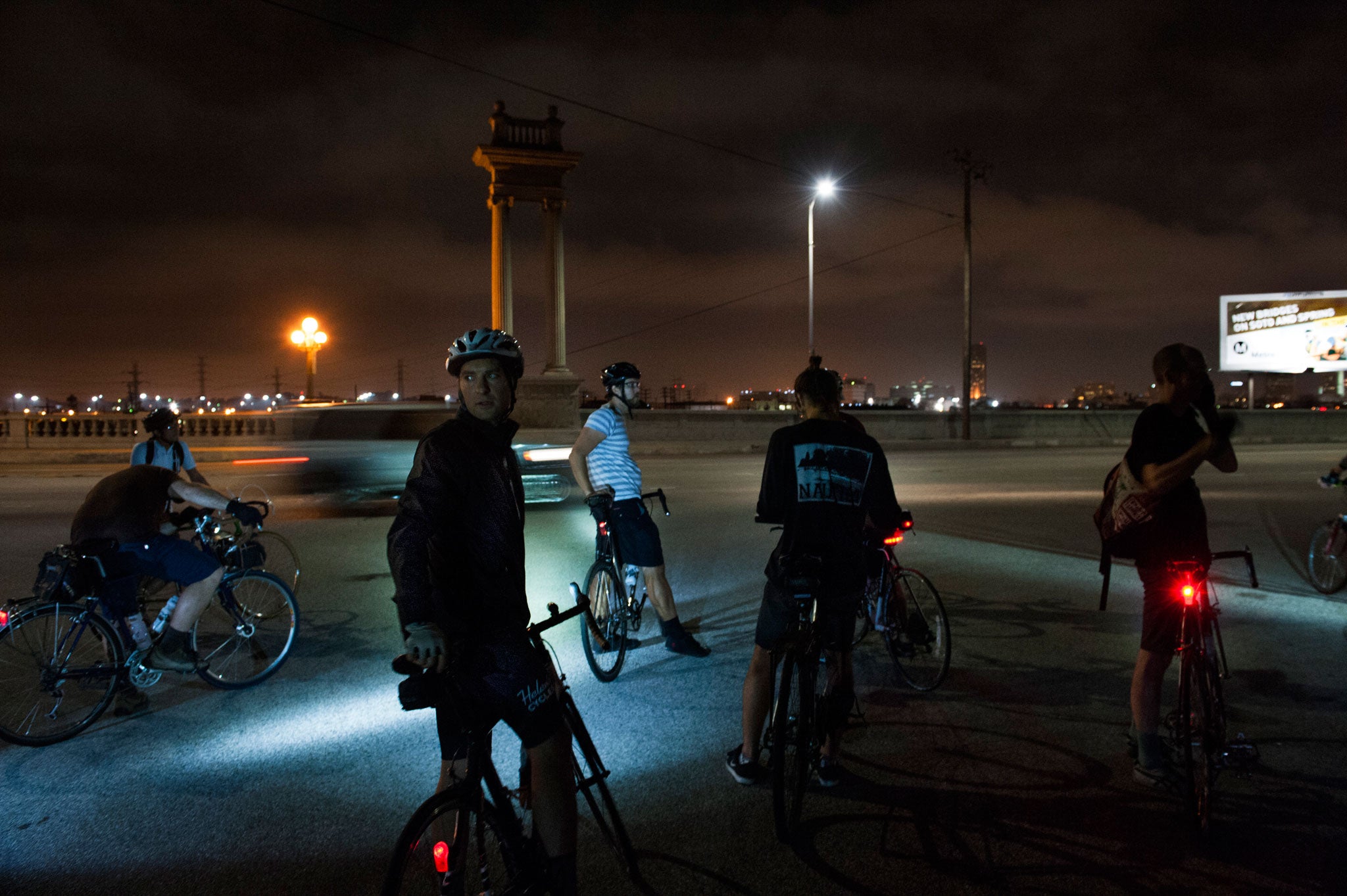
Ward thought it sounded like a fun Friday-night adventure, so he and another friend turned up with their skateboards to join six cyclists for what turned out to be an 18-mile round trip. "That was the only time I ever brought my skateboard to a Midnight Ridazz ride," he says.
At the time, the only other similar activity for cyclists in LA was Critical Mass, a global movement that stages its group rides during rush hour, and which originated in another California city, San Francisco. Critical Mass is seen as antagonistic to drivers, whereas Midnight Ridazz organised their monthly rides at night, when there was far less chance of confrontation. "It was a social thing," says Ward, who owns two SUVs. "It was never a protest."
Midnight Ridazz proved so popular that, by mid-2006, almost 2,000 cyclists would assemble late on the second Friday of each month in the car park of Pioneer Chicken, a fast-food joint in the Echo Park neighbourhood. Overwhelmed by the numbers, the organisers decided to split the ride up. Ward built a community website, midnightridazz.com, on which anybody could create a new ride, anytime, beginning anywhere in the city.
"I was hoping we'd get one ride a week somewhere in Los Angeles, so we could split that mass of riders into four groups of 500. And then, slowly but surely, all kinds of people started to create their own rides, with different themes and routes and goofy graphics and funny names. There were new rides popping up every day. It was pretty fun to watch."
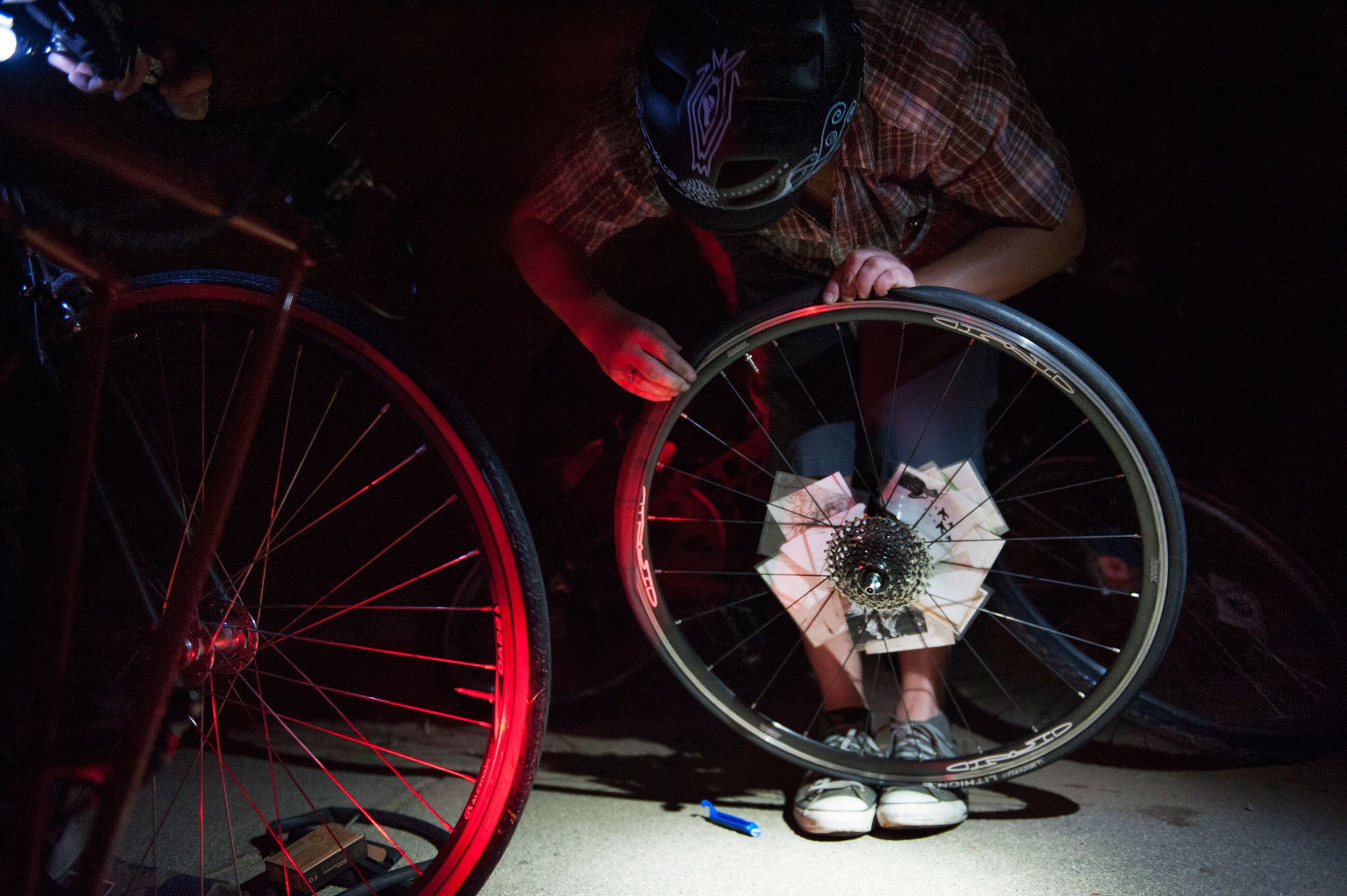
The character and intensity of a ride can often be guessed from its imaginative title: Pier Pressure; Sins and Sprockets; the International Association of Armed Librarians; Fun Patrol LA. Ward's own group began as the Tron Ride (named after the 1982 film, Tron). Its participants became known for their fast pace, scheduling their rides on Monday nights when traffic was thin and running red lights posed marginally less risk. Eventually, they renamed themselves Wolfpack Hustle.
While the early Midnight Ridazz were, as Ward puts it, "a bunch of twenty- and thirtysomething white hipster kids", word quickly spread to every demographic in town. "The community is so diverse, it's beautiful," Ward says. "With Midnight Ridazz, everybody is included no matter what. There are people who are undocumented immigrants who are major personas in the bike scene. We even have some hardcore Republicans! And that's OK. As long as you're doing something to add to the bike scene, you have a place."
Though the majority of contestants at the Midnight Drag Race are young men, there is a women's competition, too. Susie Lowbrow – a 32-year-old film production designer from Echo Park – placed 14th in the women's race last year. "Often I go on group rides and find that I'm the only girl," she says. "So a group of ladies started our own fast-paced ride called the She-Wolf Attack Team, or SWAT."
Ignorance of bicycle mechanics is not a barrier to participation. Ward himself is no bike nerd. "I can fix a bike," he says, "but as soon as people start talking about parts, my eyes glaze over. I literally don't care. My bike is an ugly 1988 Cannondale with 18 gears. I couldn't give a damn about the bike, I just want to know where we're going."
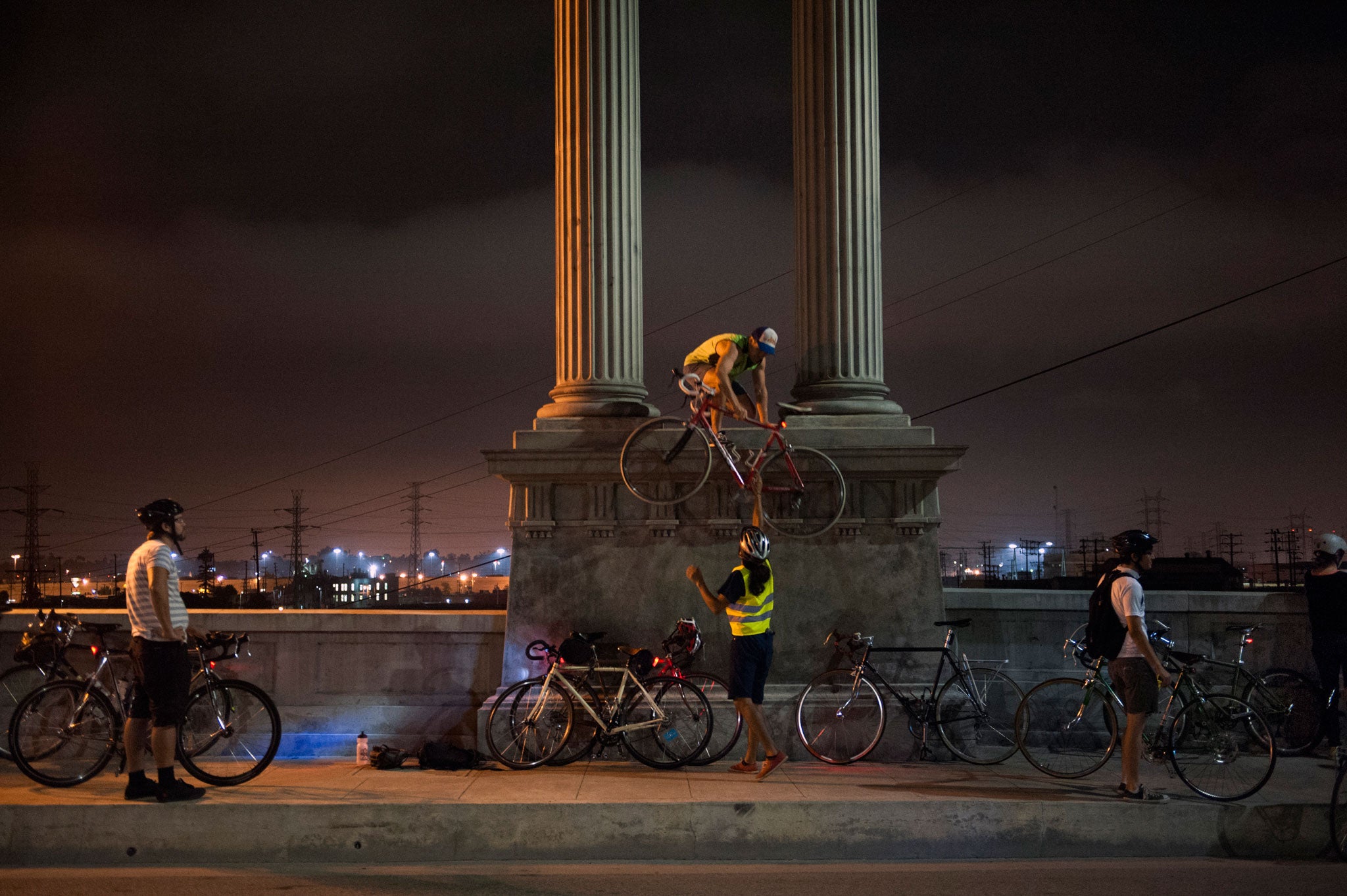
One of LA's best-regarded weekly night rides is The Passage of a Few People Through a Rather Brief Moment in Time, which I join one Wednesday evening at 8.30pm, outside California Donuts at the corner of Third and New Hampshire. Its founders, Sean Deyoe and Nathan Snider, both 35, met as Midnight Ridazz, and started their own ride in May 2009.
"There came a point where we were getting burnt out on other rides," says Deyoe. "They were separating out into slower, drinking-smoking-and-hanging-out rides; or serious, fast-paced spandex rides with people who were training to become racers. The thing that interested us most about the rides was seeing the city, so that became the raison d'être of our ride: exploration."
The mid-paced TPOAFPTARBMIT – commonly referred to as 'The Passage Ride' – is named after a film by the Situationist thinker Guy Debord, and emulates his movement's playful approach to urban geography, or 'psychogeography'. The rides are rambling and eccentric: one week, Snider planned a route by changing direction only when the names of the two intersecting streets shared a letter of the alphabet. "Most of our routes," he says, "are about looking at a map and asking ourselves where we haven't been."
Each Passage Ride route gets a title, and later a short accompanying essay on its website, thepassageride.com. Ride 218 is named, partly for my benefit, 'Bury the Lede' – a journalist's euphemism for obfuscation. And, indeed, for most of the ride I am utterly lost, until we occasionally alight upon a landmark: the Hollywood Freeway; Echo Park Lake; Dodger Stadium; Chinatown; City Hall; the American Apparel factory.
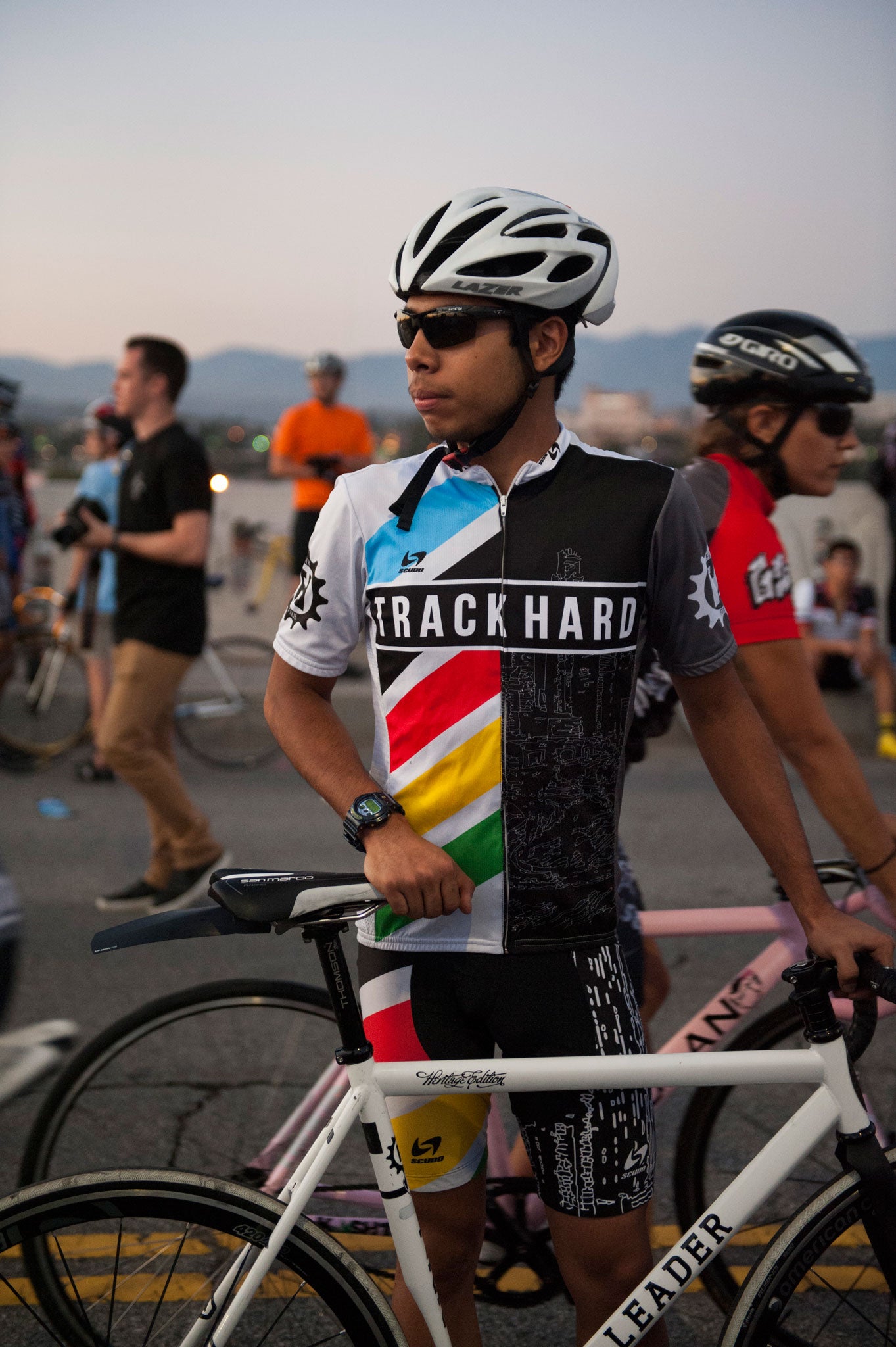
The ride winds through the city in unexpected ways: through tunnels and fences and car parks, over bridges and brownfield sites. The 30 or so riders are considerate, warning those behind them: "Pothole!" or "Car left!" or "Red light!". And when punctures occur, we all wait as they're patched, some passing round cans of craft beer. What quickly becomes clear is just what a great city Los Angeles could be for cyclists: it has sprawling flat-lands; steep, challenging hills; spectacular views; wide roads; and great weather, year-round.
By midnight, the streets are almost silent, but for the whirring of gears and the Kanye West coming from one rider's handlebar-mounted sound system. The route ends where it began, 25 miles and three-and-a-half hours later, back at the doughnut place, where the cruller pastries are warm and fresh.
Biking may be booming in LA, but that's not to say it's entirely safe. The city suffers from an epidemic of hit-and-run incidents – some 20,000 every year. Approximately 22 cyclists are killed or seriously injured annually by hit-and-run drivers. One night in May 2009, Ward himself was struck by a Jaguar, which sped away, leaving him lying by the side of the road, still clipped to his bike.
Ward had the wherewithal to tweet six of the seven digits of the car's registration number, which he later re-posted to the Midnight Ridazz website. The police showed little interest, but the cycling community came together to track down the perpetrator, who turned out to be a hotshot local lobbyist. Ward had no broken bones, so the man was charged only with misdemeanour for property damage and fined $500, though Ward later sued him and won a private settlement.
"I've also seen a hit-and-run happen on a Wolfpack ride," Ward recalls. "We were riding legally, taking up one lane, and a driver just right-hooked into the group and wiped out one of the riders. We tried to catch him but he drove on to the freeway off-ramp to get away. We made a noise about it [to the police] but nobody cared... I want the cops to recognise us as traffic and to protect us more. I want to have a friendly relationship with the LAPD."
Arthur Alfaro has had his fair share of accidents, too. "I've been hit three times," he explains. "Once I went straight over the hood of a car. I didn't break anything but I messed up my right shoulder really bad and had to have physiotherapy. My spinal cord is crooked in two spots. The doctors said cycling is healthy for me, 'But just don't hit any more cars!'."
Back at the Sixth Street Bridge, the LAPD is taking a light-touch approach to the Drag Race. There appears to be a total of two cops policing the event, and they spend most of the evening within easy reach of the taco truck. The riders zip by beneath the streetlamps, with Ward's enthusiastic race commentary wafting the length of the track.
It's well into the wee hours by the time the final results begin to come in. Susie Lowbrow covers the 1,000-foot course in 30.26 seconds, just outside qualifying for the women's last 16. Arthur Alfaro posts a highly respectable 25.35, which ranks him 41st in the overall table – and hey, he's young, he'll be back next year. Edgar 'Willo' Juarez comes in second with a tasty 22.89, but his performance is sufficient to secure him overall victory in the Unified Series. The win is well-deserved. For most of those here, though, it's the taking part that counts.
Join our commenting forum
Join thought-provoking conversations, follow other Independent readers and see their replies
Comments